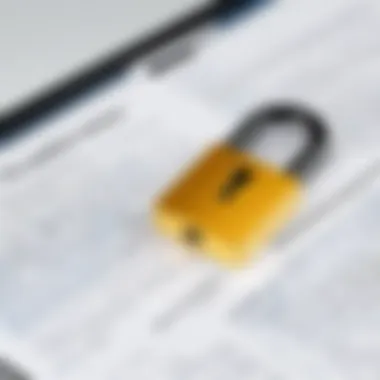Understanding AESCrypt: Your Guide to File Encryption


Intro
In a world where digital data is increasingly vulnerable, the importance of encryption cannot be overstated. AESCrypt offers a robust solution for securing sensitive information through file encryption. By using the AES (Advanced Encryption Standard) algorithm, this software tool enables users to protect their data from unauthorized access effectively. In the subsequent sections, we will explore the key features of AESCrypt, its pricing models, and other relevant aspects that can help IT professionals, business owners, and decision-makers understand its significance in today's cybersecurity landscape.
Key Features
Overview of Features
AESCrypt stands out due to its simplicity and efficiency. It provides a secure way to encrypt files without overwhelming the user with complex procedures. Some of its primary features include:
- Strong encryption: Utilizing AES, a universally accepted standard, AESCrypt offers high-level security.
- Cross-platform support: Available on multiple operating systems, it caters to a broad user base, ensuring accessibility.
- User-friendly interface: AESCrypt is designed for both novices and experienced users, making encryption accessible to everyone.
- Flexible file size compatibility: Whether dealing with small documents or large files, AESCrypt handles them all with ease.
- Integration with existing workflows: It can be seamlessly integrated into current practices without requiring significant changes.
Unique Selling Propositions
AESCrypt’s unique selling propositions revolve around its reliability and simplicity. Unlike many encryption tools, it does not require extensive technical know-how. The following aspects set it apart:
- Speed and performance: AESCrypt processes encryption quickly, which is crucial in environments where time is of the essence.
- No hidden costs: The transparency in its pricing model assures users they pay only for what they need, without extra fees.
- Strong community support: With an active user community, getting assistance or advice is easier.
"AESCrypt empowers users to protect their vital data effortlessly, standing out through its combination of strong security and ease of use."
Pricing Models
Different Pricing Tiers
The pricing structure of AESCrypt is straightforward, allowing users to select the model that best meets their needs. It typically consists of various tiers, catering to both individual users and businesses. Different plans may include:
- Free version: Basic features for individual users wanting to try it out.
- Pro version: Advanced features with a monthly or yearly subscription for businesses.
- Enterprise solutions: Custom plans for large organizations with specific needs.
ROI and Cost-Benefit Analysis
When considering any encryption solution, return on investment is vital. AESCrypt provides both security and efficiency, offering notable benefits such as:
- Reduction in data breaches: Protecting sensitive information can prevent costly breaches.
- Improved compliance: Helps organizations meet regulatory requirements related to data protection.
- Enhanced trust: Establishing a secure environment fosters trust between businesses and clients, aiding customer retention.
AESCrypt's cost-benefit ratio proves favorable, particularly for industries where data confidentiality is paramount. By investing in effective encryption, businesses can safeguard their assets against the threats prevalent in today's digital arena.
Intro to AESCrypt
AESCrypt is an essential tool in the realm of file encryption, specifically leveraging the Advanced Encryption Standard (AES). The importance of this topic cannot be overstated. In today’s digital landscape, where data breaches and cyber threats are prevalent, securing sensitive information is vital for individuals and organizations alike. Understanding AESCrypt not only aids users in safeguarding files but also empowers them with the knowledge to navigate their digital security strategies effectively.
Recognizing how AESCrypt functions provides insights into its significant role in encrypting data. This article examines the elements that make AESCrypt a reliable choice for file encryption. Its robust features, streamlined user experience, and adaptability across different systems enhance its applicability across various sectors. Additionally, understanding AESCrypt contributes to informed decision-making by IT professionals, business leaders, and entrepreneurs who must consider the encryption tools best suited for their operations.
What is AESCrypt?
AESCrypt is a file encryption software that utilizes the AES algorithm to secure data. It provides users an intuitive platform for encrypting files, ensuring that sensitive information remains inaccessible to unauthorized parties. The software employs strong encryption techniques that conform to international standards, making it a trustworthy solution for safeguarding data.
The simplicity of AESCrypt's design allows even those with minimal technical skills to encrypt and decrypt files effectively. When a user encrypts a file with AESCrypt, the software requires a password. This password is crucial as it acts as the determining factor that allows access to the data after encryption.
Historical Context and Development
AESCrypt emerged from the increasing need for robust file encryption solutions in a world increasingly fraught with cyber threats. The AES algorithm itself was established in the late 1990s as a response to vulnerabilities found in the previous encryption standards. It was adopted by the U.S. government for protecting sensitive but unclassified information, which lent credibility to its robustness and effectiveness.
The development of AESCrypt closely followed the advancements in encryption technology. Its creators aimed to provide users with a straightforward and secure method to protect files, allowing individuals and organizations to manage their digital data responsibly. Over time, AESCrypt has evolved, integrating updates to address new security challenges and offering greater compatibility across platforms. This evolution is critical in maintaining its relevance in an ever-changing digital environment.
The Basics of AES Encryption


The importance of understanding the basics of AES encryption cannot be overstated, especially for those involved in technology, data management, or cybersecurity. The Advanced Encryption Standard, or AES, serves as one of the most prevalent encryption methods available today. This section lays the groundwork for comprehending how AESCrypt utilizes AES to secure files, ensuring sensitive information remains protected against unauthorized access.
Understanding AES Algorithm
The AES algorithm is a symmetric key encryption technique that uses the same key for both encryption and decryption. Developed by Vincent Rijmen and Joan Daemen, it became the encryption standard adopted by the U.S. government in 2001. Its significance lies in its strength and efficiency, marked by the following characteristics:
- Block Cipher: AES operates on fixed-size blocks of data. Each block consists of 128 bits, ensuring uniformity in processing.
- Key Sizes: AES supports key lengths of 128, 192, and 256 bits. Longer keys increase security but may slightly affect processing speed.
- Rounds of Encryption: Depending on the key length, AES performs 10, 12, or 14 rounds of encryption. Each round involves a series of transformations to ensure a secure final output.
In the realm of encryption, the AES algorithm is recognized for its robustness and resistance to cryptographic attacks. Its cryptographic strength has made it a favorite among professionals and organizations seeking reliable security solutions.
AES Key Sizes and Security Levels
The choice of key size plays a crucial role in the security level of AES encryption. Each key length offers different levels of protection against potential threats:
- 128-bit Key: This is the minimum key size for AES. It is adequate for most applications and provides a significant level of security.
- 192-bit Key: Provides added security and is more suitable for environments requiring elevated protection levels. This extra length makes it harder to crack.
- 256-bit Key: This is for organizations requiring the highest level of security. It provides a significant barrier against brute force attacks and is often used in government and military applications.
As technology advances, potential threats evolve, making it essential to select an appropriate key size that aligns with the security requirements and data sensitivity involved. The importance of using the correct AES key size cannot be ignored in any encryption strategy.
"The security of AES encryption is directly tied to the key size and the implementation practices."
Understanding these key basics ensures that users can make informed decisions regarding their encryption needs. By comprehending how the AES algorithm functions and the implications of key sizes, users are better equipped to protect their sensitive data effectively.
Features of AESCrypt
The features of AESCrypt are crucial for understanding its role as a reliable file encryption tool. AESCrypt’s design emphasizes not just security but also accessibility and practicality for its users. Below are the main features that define AESCrypt, emphasizing convenience, adaptability, and functionality crucial for various users and organizational environments.
User-Friendly Interface
AESCrypt's user interface is designed with simplicity in mind. Upon installation, users encounter a layout that prioritizes ease of navigation. This accessibility is essential because encryption software can often be complex and intimidating. The clear categorization of options allows both novice and advanced users to effectively engage with the tool without feeling overwhelmed.
A notable aspect of the interface is its straightforward encryption and decryption process. Users can drag and drop files into the application, streamlining the method of securing sensitive information. Furthermore, the application provides intuitive prompts and feedback, which guide users through each step, making the learning curve less steep than many alternatives in the market.
Cross-Platform Compatibility
AESCrypt is distinguished by its cross-platform compatibility. Available on Windows, macOS, and Linux, it ensures that users across various operating systems can benefit from its features without requiring multiple tools for different platforms. This flexibility is vital in today’s diverse technological landscape, where business environments often integrate various systems.
For organizations operating on mixed platforms, AESCrypt becomes a unified solution, preventing fragmentation and enhancing overall efficiency. Users can easily share encrypted files across different operating systems, ensuring smooth collaboration without compromising security.
File Compression Capabilities
AESCrypt offers an additional feature that sets it apart from many encryption tools: file compression. This function not only encrypts files but also reduces their size, making it easier to store or transmit data, a significant consideration in environments where bandwidth and storage capacity are often limited.
The integration of compression alongside encryption means that users can save on resources without sacrificing security. When files are smaller, they take less time to upload or download, which can be particularly beneficial for businesses that routinely handle large datasets. This dual functionality exemplifies how AESCrypt combines efficiency with robust security measures, catering to the needs of modern data management.
AESCrypt stands out as a user-friendly, adaptable, and resource-efficient tool, central to effective data security in any tech-savvy organization.
How to Implement AESCrypt
Implementing AESCrypt is a crucial step in leveraging its powerful file encryption capabilities. This process ensures that sensitive information is protected through robust encryption. Understanding how to install, encrypt, and decrypt files using AESCrypt is essential for anyone looking to secure their data effectively. The importance of proper implementation cannot be overstated, especially in sectors where data privacy is paramount, such as finance, healthcare, and technology. Ensuring that these methods are followed critically enhances the effectiveness of data protection strategies.
Installation Process
The installation process of AESCrypt is straightforward, making it accessible for users of all technical levels. Here are the steps to follow:
- Visit the Official Website: Navigate to the AESCrypt download page found at the official AESCrypt website.
- Download the Installer: Choose the appropriate version for your operating system—Windows, macOS, or Linux—and download the installer.
- Run the Installer: After the download completes, locate the file and double-click it to begin the installation. Follow the prompts of the installation wizard to complete the setup.
- Launch AESCrypt: After installation, locate the application on your computer and open it. It is now ready for use.
Ensuring that you download AESCrypt from a reliable source is critical to avoid any security risks. Regular updates are also important to maintain security integrity against new vulnerabilities.


Encrypting Files Step-by-Step
Once AESCrypt is installed, encrypting files is a simple process. Follow these steps for effective encryption:
- Open AESCrypt: Launch the application on your device.
- Select the File: Use the file explorer within AESCrypt to navigate to the file you wish to encrypt.
- Set a Password: You will be prompted to enter a password. Choose a strong password that combines letters, numbers, and symbols.
- Start the Encryption: Click on the encrypt button. AESCrypt will start processing the file. Once completed, the original file will remain, and an encrypted version will be generated.
It’s important to remember your password, as losing it means losing access to your encrypted file.
Decrypting Files: A Quick Guide
Decrypting files is just as simple as encrypting them. Here’s how to do it:
- Open AESCrypt: Start the application as you did during the encryption process.
- Locate the Encrypted File: Use the file explorer to find the encrypted file you want to decrypt.
- Enter the Password: When prompted, enter the same password used during encryption.
- Decrypt the File: Click the decrypt button to restore your file to its original state.
This quick process is essential for accessing the data when needed. Failure to remember the password may cause significant inconvenience.
Important Note: Always back up your passwords securely. Using a password manager can help you keep track of your various passwords without compromising security.
Comparative Analysis with Other Encryption Tools
Understanding how AESCrypt stands against other encryption tools is crucial for readers seeking the best file encryption methods. Comparing AESCrypt with its peers helps inform users about its strengths, weaknesses, and specific use cases. It empowers decision-makers, IT professionals, and entrepreneurs to choose the right tool according to their needs. This section delves into two prominent encryption solutions: VeraCrypt and BitLocker.
AESCrypt vs. VeraCrypt
VeraCrypt is a popular choice among users needing encryption. It is known for its robust security features and advanced encryption algorithms. However, there are some key differences between AESCrypt and VeraCrypt.
- Encryption Method: AESCrypt uses the AES algorithm primarily for file encryption, while VeraCrypt supports multiple encryption options, including AES, Serpent, and Twofish. This flexibility allows users to select based on their particular security requirements.
- Ease of Use: AESCrypt offers a more straightforward user interface. Users can encrypt files with just a few clicks. In contrast, VeraCrypt has a steeper learning curve due to its complex features and options, making it potentially less suitable for novice users.
- Portability: AESCrypt is lightweight and portable. Users can easily carry the application on a USB drive. VeraCrypt may require installation and integration that can be more cumbersome for some users.
- Security Features: While AESCrypt offers strong encryption, VeraCrypt has advanced features like hidden volumes and plausible deniability, which can be valuable for specific users needing increased anonymity.
Each tool has its advantages and can serve different purposes. Depending on user needs, AESCrypt might be favored for its simplicity, whereas VeraCrypt could be chosen for its enhanced security options.
AESCrypt vs. BitLocker
BitLocker is a built-in encryption tool in Windows operating systems. It is designed to protect entire drives rather than individual files. Comparing BitLocker with AESCrypt reveals notable contrasts:
- Encryption Scope: AESCrypt focuses on file-level encryption, allowing users more granular control. BitLocker encrypts entire disk volumes, offering broader protection but at the cost of versatility.
- User Experience: AESCrypt's interface is generally simpler to navigate for those who primarily need to encrypt specific files. BitLocker requires users to manage drive encryption settings, which may not be necessary for everyone.
- Integration: BitLocker integrates seamlessly with Windows, making it a good choice for Windows users who prioritize system-wide security. AESCrypt can be used across various operating systems, adding to its versatility for diverse workflows.
- Recovery Options: BitLocker has built-in recovery methods, including recovery keys and recovery partitions. In contrast, AESCrypt relies on user-generated passwords, making it essential for users to create strong passwords and manage them carefully.
Use Cases of AESCrypt
AESCrypt is more than just a tool; it plays a vital role in the protection of sensitive information across various sectors. Understanding its use cases sheds light on the different ways organizations and individuals can implement this encryption tool to enhance security. From corporate environments to independent professions, the adaptability of AESCrypt is noteworthy. As cybersecurity becomes an increasing priority, knowing how to effectively utilize AESCrypt is essential for safeguarding data.
Applications in Corporate Settings
In corporate environments, data protection is paramount. AESCrypt provides organizations with the means to secure sensitive information effectively. Companies often handle confidential files, intellectual property, and personal data, making robust encryption solutions necessary. By employing AESCrypt, businesses can encrypt documents, presentations, and other important files before sharing them internally or externally.
Using AESCrypt minimizes the risk of data breaches. If a file were to fall into unauthorized hands, the encryption ensures that the data remains unreadable without the correct password.
Key Benefits for Corporations:
- Secure Communication: Teams can share files without fear of interception, enhancing collaboration while maintaining confidentiality.
- Regulatory Compliance: Many industries are subjected to regulations such as GDPR. Encrypting files aligns with legal requirements for data protection.
- Risk Management: Reducing the risk associated with data exposure helps in maintaining the company's reputation.
Utility for Freelancers and Entrepreneurs
Freelancers and entrepreneurs often work with clients' sensitive information. Whether it is contracts, financial documents, or creative works, securing these files is crucial. Using AESCrypt allows independent professionals to protect their data without requiring IT security teams.
AESCrypt’s simplicity makes it accessible for those who may not be tech-savvy. Startup founders, in particular, can easily implement file encryption, offering a layer of security that builds trust with clients.
Important Considerations for Freelancers:


- Client Trust: Demonstrating diligence in data protection fosters client confidence and loyalty.
- Cost-Effectiveness: AESCrypt provides a reliable and budget-friendly solution compared to comprehensive cybersecurity measures.
- Convenience: It allows for quick encryption and decryption, saving time when handling multiple projects.
"In a world where data breaches are commonplace, using tools like AESCrypt becomes not just a luxury but a necessity for protecting information."
Potential Drawbacks of AESCrypt
While AESCrypt presents an array of features that make it a formidable tool for file encryption, it is essential to consider its drawbacks. These limitations can affect user experience and security outcomes, making it important for decision-makers to be fully informed. Here, we will delve into two significant drawbacks: performance issues and dependency on user practices.
Performance Issues
Performance is a critical factor when it comes to file encryption software. AESCrypt, despite its efficiency and ease of use, can exhibit performance issues, particularly when encrypting large files. As the file size increases, the process may slow down, impacting productivity. This lag can be frustrating in a fast-paced work environment where time is of the essence.
In general, the encryption process requires computational power, which can lead to increased CPU usage. If a computer's hardware is not optimized for encryption tasks, users might notice a significant drop in system performance during the encryption and decryption processes. This may lead to interruptions or delays in other applications running concurrently.
Additionally, when users operate on devices with limited resources, such as older computers or mobile devices, the performance can degrade further. It is essential for users to assess their hardware capabilities before using AESCrypt, especially for batch processing of multiple large files. Regular system maintenance and updates may somewhat alleviate these performance issues, but the risk of slowdowns remains.
Dependency on User Practices
Another notable drawback of AESCrypt is its reliance on user practices. Effective encryption does not solely depend on the software itself; it also hinges on how users implement and manage their encryption tasks. Poor user practices can compromise the intended security benefits of AESCrypt.
One common issue is the creation of weak passwords. Even though AESCrypt supports strong encryption algorithms, using easily guessed or weak passwords undermines its effectiveness. Users should prioritize creating complex passwords that include a mix of numbers, symbols, and upper and lowercase letters.
Furthermore, inconsistent procedures for encrypting and decrypting files can lead to confusion, resulting in potential data mishaps. Users must develop a standardized method for handling sensitive files throughout their lifecycle, including storage and sharing, to maintain security integrity.
Lastly, the dependence on user training cannot be overstated. Without proper understanding of how AESCrypt functions and how to utilize its features effectively, users may inadvertently expose their data to risks. Training sessions and detailed documentation can be beneficial in addressing this issue, enhancing user competency.
In summary, while AESCrypt is a powerful tool for file encryption, acknowledging its potential drawbacks is crucial for maximizing its benefits.
Best Practices for Using AESCrypt
Effective use of AESCrypt, like any software tool for encryption, hinges on employing best practices. These practices enhance the software’s ability to secure files. Adhering to them can mitigate vulnerabilities and enhance overall data protection. For users, especially in professional settings, understanding these practices is essential.
Creating Strong Passwords
Creating strong passwords is the most fundamental practice in using AESCrypt. Passwords serve as the first line of defense. A weak password can render even the best encryption useless.
To ensure password strength, consider these guidelines:
- Use a Longer Password: Aim for at least 12 characters. The more characters, the harder it is to crack.
- Include Diverse Characters: Use uppercase letters, lowercase letters, numbers, and symbols. A mix increases complexity.
- Avoid Personal Information: Do not use easily accessible information like birthdays or names. This info can be guessed.
- Consider a Passphrase: Instead of a single word, use a phrase that is easy for you to remember but hard for others to guess.
Using strong passwords particularly increases security against brute-force attacks.
Regular Software Updates
Regular software updates are critical for maintaining the integrity of AESCrypt. Software developers frequently release updates to patch vulnerabilities and improve performance. Failing to update can leave a system exposed to known exploits.
Here are some considerations:
- Enable Automatic Updates: Whenever possible, enable this feature to ensure you always have the latest version.
- Check for Updates Periodically: If automatic updates are not an option, set a reminder to check for updates regularly.
- Read Release Notes: These notes can help you understand what changes have been made and how they benefit your security.
Keeping AESCrypt updated minimizes the risk of security flaws and ensures that it operates efficiently.
The End
The conclusion of this article plays a pivotal role in synthesizing the information discussed regarding AESCrypt. This software tool stands as a significant player in the landscape of data encryption, especially for those who prioritize security in their digital environments. AESCrypt, underpinned by the AES algorithm, provides robust features that cater to various user needs including businesses and individual users.
In evaluating the importance of AESCrypt, key benefits emerge. These include the simplicity of the installation process, ease of use, and cross-platform compatibility. This adaptability ensures that users across different devices can safeguard their data effectively. Furthermore, AESCrypt's focus on file compression while encrypting enhances its functionality, allowing for efficient storage management.
"AESCrypt empowers users to control their sensitive data with a manageable solution that integrates seamlessly into their daily workflows."
However, as this article outlines, there are considerations to keep in mind. Performance can be an issue, particularly with larger files, and reliance on user practices plays a critical role in the effectiveness of the encryption. Users should be mindful of these potential drawbacks while leveraging AESCrypt.
Ultimately, businesses and individuals alike can realize significant security benefits by integrating AESCrypt into their data protection strategies. Understanding the strengths and limitations of AESCrypt not only equips users with the right tools for secure file management but also empowers them to make informed decisions about their cybersecurity posture. Secure your sensitive data with confidence, knowing that AESCrypt provides a solid layer of encryption support.















